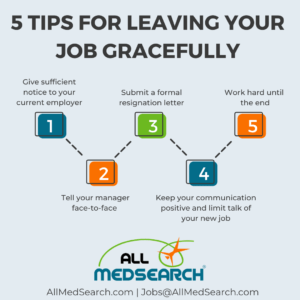
Have you recently found a new position and aren’t sure of how to leave your current position? Are you thinking about quitting but are unsure how?
If you’re considering leaving your current job—especially one you hate—it might be tempting to quit on the spot and walk out. But learning how to quit a job gracefully is an important skill you will use throughout your life.
You may be asking yourself “Why should I leave on good terms?”—especially if it isn’t a job you enjoy. Well, leaving on good terms ensures that your former employer will give you a good reference if asked and that your boss and co-workers will remain a part of your professional network—both of which will help you to land better opportunities in the future.
No matter what your reason is, deciding how to leave your job can be challenging.
So, before you do anything impulsive, read through our tips to walk you through how to leave your job gracefully.
Start by making sure it is the right time to quit and that you actually want to quit.
Take the time to carefully consider why, when and how you should leave your job. If you are not 100% sure about it, make a pros and cons list. Some questions to ask yourself include:
- Why do I want to leave?
- Have I done everything I can to try and improve the situation?
- Would I really be happier elsewhere?
- Do I know what I want to do next?
Taking the time to answer these questions (and questions like them) can help you feel more confident that staying or going is the right decision for you and your career.
Make sure that you’re wanting to leave for the right reasons, rather than quitting because you’re having a bad week and it seems like it won’t get better any time soon.
Make a plan for what comes next for you before you start notifying your employer.
Before putting in your notice, it’s a good idea to have a post-employment plan in place. Start by updating your resume and cover letter to reflect your current positions. Be sure to include the responsibilities and projects you’ve taken on in your current position. Then, start applying to new jobs, or reach out to an All Med Search recruiter for help finding opportunities.
Once you have your interview scheduled, check out our blog for more tips and tricks on how to nail your interview!
Give your employer sufficient notice.
The standard notice for leaving your position is two weeks. However, if you’ve signed an employment contract, make sure you are honoring any rules around the length of notice that are set. Even if you are desperate to go, leaving before giving two weeks’ notice could potentially hurt your professional reputation. Giving sufficient notice shows respect for your employer, as well as gives them sufficient time to find someone to take over your current position.
Depending on your availability, you may be willing to stay longer than the typical two-week period—especially if your new job doesn’t start for several weeks or you’re transitioning to self-employment. Regardless of the length of notice you provide, be sure to let your employer know as soon as possible and include this information in your resignation letter.
Write formal Letter of Resignation.
A written Letter of Resignation notifies your boss that you’re planning on leaving. It also provides both you, your manager or supervisor and Human Resources a record of your resignation.
Include the following in your resignation letter:
- The date you are submitting the letter at the top.
-
A statement that you’re resigning
-
Date on which your resignation is effective
-
Why you are leaving (optional)
-
Thank you
-
Signature
Schedule a meeting with a Human Resources representative and/or supervisor.
Instead of emailing your resignation to your boss or letting them find out about your departure from Human Resources, consider scheduling a one-on-one meeting; depending on your relationship with them. This meeting can be an excellent time to thank them for the opportunities they have provided you and you can work on a plan to wrap up your projects before you leave.
While scheduling a face-to-face meeting is good etiquette, keep in mind that it’s not required. If you don’t have a positive relationship with your supervisor or you’re concerned about how they’ll react, you might want to talk to the Human Resources department about leaving first.
Keep your communication positive and limit talk of your new job.
During your last weeks at your current employer, be sure to keep your communication positive and limit talks of your new job. No matter how much you dislike your job, make your transition a positive one with your bosses and co-workers.
When asked why you’re leaving, it’s best to avoid gossip or complaints about the work environment. Be sure not to give a big story about why you’re leaving — it is not necessary. Be brief and honest while being careful with your words.
Work hard until the end and connect with your colleagues.
Even though you are excited for your new opportunity, be sure to keep working as you normally would up until your last day.
Before you leave, make sure colleagues know where they can reach you. Take time to personally thank co-workers and leaders with whom you’ve worked closely. Not only is this proper etiquette, but it can also help you grow your network. You never know when you may be in a position to help a former colleague find a new opportunity and vice versa.
Now that you’ve learned how to quit a job gracefully, you can start the next stage of your career on a positive note. Need help finding a new job before you quit? Be sure to connect with an All Med Search recruiter!
Our recruiters offer tons of resources to help you throughout your job search. Talk to us today to find you a job that you won’t want to quit. Jobs@AllMedSeach.com or 858-509-1464
